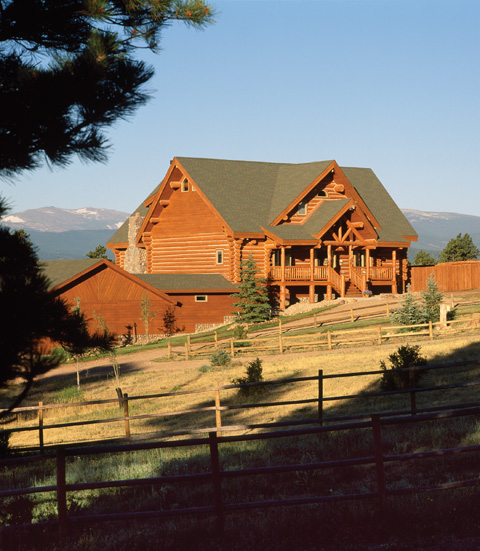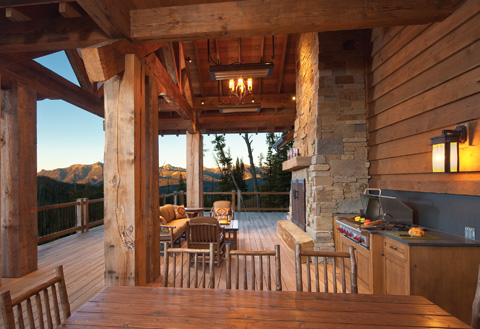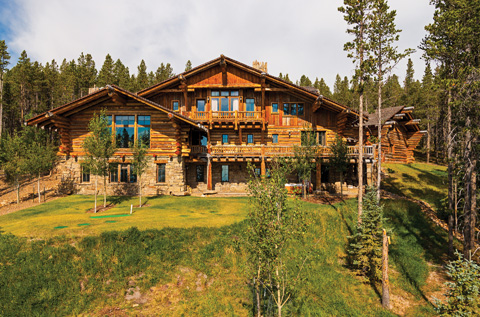Many people dream about a relaxing getaway, and for log home enthusiasts, a home in the mountains may be the ideal choice. Not only do the mountains offer breathtaking views, but often they offer exciting glimpses of wildlife and proximity to outdoor activities such as skiing or hiking.
“A mountain home is a place that’s laid back and away from the hustle and bustle of everyday life,” says Sarah Smith, marketing coordinator at Blue Ridge Log Cabins in Campobello, South Carolina. “Whether you live in it year-round or just during vacations, it’s a relaxing destination. Log homes have a soothing effect, and when you combine the beauty of the mountains with the beauty of a log home, it just works.”
Finding the right parcel of land in a pristine mountain setting may take a while. Here are some factors to consider before buying mountain property.
Location, Location, Location
Target your search for mountain properties only in areas where you’d be willing to relocate or take vacations frequently. If it’s a vacation property, consider the distance from your primary residence. Is it close enough that you’ll be able to travel there as often as you would like to? Or maybe you’d like something that is a long drive or airplane flight away. For primary residences, make sure the property is located in a place where you can see yourself living year-round. Also consider how close you want to be to neighbors, as well as how close the property is to town. Are there shopping centers, medical facilities, and good schools close by? Does this destination offer everything you need and want?

Log Knowledge/photo by Roger Wade
The View
One of the main reasons people want to buy land in the mountains is to enjoy stunning views. Do you want land that has a breathtaking, distant view, or property that lends itself to a home that is peacefully tucked into the mountainside? Along with that, think about how close you’d like to be to other families. Do you want an isolated piece of property or do you want to live close to neighbors? Search for a piece of land that will give you the types of views you want.
“Views are a big thing for most homeowners,” Smith says. “If you’re planning on incorporating a lot of porches and decks onto your home, what will those features overlook? How many people do you want around you? Do you want to be able to see your neighbors’ homes or feel more secluded?”
Lay of the Land
Before signing a contract to purchase mountain land, carefully consider whether the site is flat or sloping, how much rock needs to be removed, and how many trees need to be cleared away. These features all have an impact on the overall cost.
“Mountain land typically requires more site preparation than flat lots,” says Craig Johnson, president of the U.S. Division of Timber Block in Hildebran, North Carolina.

Locati Architects; SBC/photo by Karl Neumann
While some mountain lots can present construction challenges, a creative builder or architect can find solutions for almost any type of property. Even so, homeowners must consider the cost of the land versus cost of building on the parcel they’ve purchased.
“The lowest cost property to build on is a flat piece of property—so the steeper the slope, the greater the cost of building the house,” says Allen Halcomb, architect and president of MossCreek in Knoxville, Tennessee. “You may think you’re getting a great value by paying very little for a sloping piece of property, but when you start talking to builders, you may realize there’s an additional $100,000 tacked onto the house just to get the foundation in place. It’s easy to be lured into a low-cost piece of property that’s almost unbuildable, but the problem is you recapture all the money you saved, plus some, when you start building the house. That’s a risk you need to analyze.”
Planned Community or Raw Land?
Prospective buyers should consider whether they want to buy land in a planned community that is already developed (or in the process of development) or if they prefer to stake out new territory in a more remote or rural site. An undeveloped, remote lot will likely cost less, but you’ll still have to pay to hook up utilities, construct a driveway or road to access the property, and prepare the lot for the building project.
Planned communities may be gated for security and offer amenities such as parks, golf courses, or recreation centers—and possibly even landscaping and maintenance services. If you’re buying in a more secluded site, find out the zoning ordinances for the surrounding properties, and be sure the lot you want to buy has a clear title and is free of liens, easements, and encumbrances.

Maple Island Log Homes/photo by Roger Wade
Resale Value
All of these factors combined will influence the property’s value—and that’s an important consideration for any buyer. As you begin searching for the perfect mountain parcel, analyze the sales statistics of the local real estate market.
“Because it’s such a sought-after thing to have a house in the mountains, if you do get a great piece of land, the value will very likely increase over time,” Smith says. Even though mountain land tends to hold its value, chances are that log home owners intend to keep it in the family for generations to come.
“Building on a mountain can be a bit of a challenge, but at the same time homeowners are pleased with the product,” Johnson says. “Some of the most breathtaking homes we’ve done have been perched on top of a mountain.”

